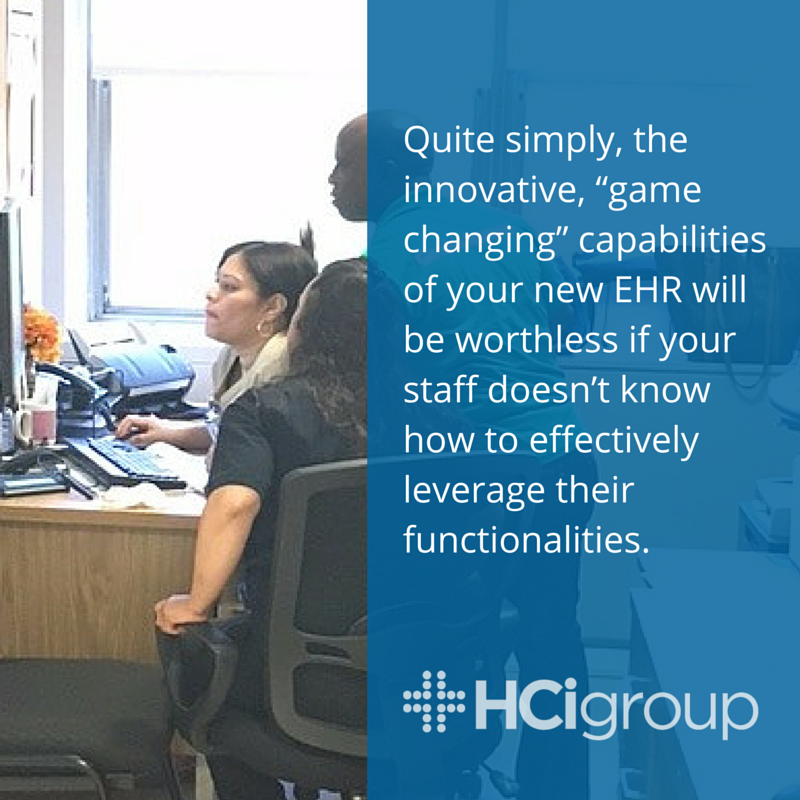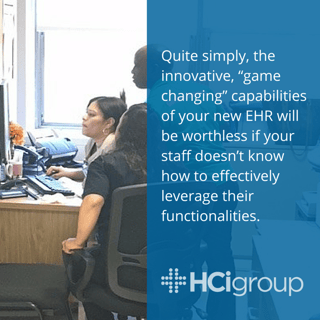Go-Live Support: Training and Super-User Support

If you’ve been keeping up with our weekly “Go-Live Support” blog, you’ll be familiar with the concepts in last week’s “Pre & Post Go-Live Planning” post. If you haven’t read it yet, be sure to check it out before you read this post, as you’ll find that many of the ideas overlap and complement each other. The first post of the “Go-Live Support” series can be found here: “Operation Communication.”
This week’s post, developed with David Chou (VP/CIO, Children’s Mercy Hospital), Stephen Tokarz (HCI Senior VP, Training & Activation), and Bob Steele (HCI Executive VP, Clinical Services), will focus on your end-user training program, as well as your Super User training and support plan. Both before and after Go-Live, effective training strategies will be essential to the success of your project. Quite simply, the innovative, “game changing” capabilities of your new EHR will be worthless if your staff doesn’t know how to effectively leverage their functionalities. Similarly, if you don’t have confident Super Users prepared to assist your end-users and refresh some of the concepts taught in training, you could end up with serious deficiencies in your staff’s use of the new system.
1. EUPA and Competency-based Checklists
 This point is pretty straightforward. EUPAs (End User Proficiency Assessments) and Competency-based Checklists should be completed by the training team at the time of training, not during the actual go-live. It seems obvious, but sometimes these are forgotten about until Go-Live commences, resulting in inadequately prepared staff and a rush to get the necessary certifications completed, when your staff should really be concentrating on running and learning the new EHR.
This point is pretty straightforward. EUPAs (End User Proficiency Assessments) and Competency-based Checklists should be completed by the training team at the time of training, not during the actual go-live. It seems obvious, but sometimes these are forgotten about until Go-Live commences, resulting in inadequately prepared staff and a rush to get the necessary certifications completed, when your staff should really be concentrating on running and learning the new EHR.
2. Super User Engagement
As the first line of support for your end-users, it is imperative that your Super Users are prepared to assist other staff the minute that Go-Live begins. To make sure they’re ready, engage Super Users on a weekly basis during the period between Super User Training and Go-Live. Often, Super User training will take place several months before the actual Go-Live; your end-users will typically get training in the several weeks leading up to Go-Live. Early training for Super Users is great because it gives them time to learn the system on a deeper level. However, much of the information learned can be lost over the months prior to Go-Live if Super Users aren’t regularly engaged after their training is over. In such cases, you may unfortunately find that your end-users are more savvy with the system than the Super Users. If there is a lapse in involvement, there is a chance they will not feel confident and empowered to support their peers.
At a previous project, the support plan called for 400 Super Users to provide adequate assistance to the large number of end-users. However, when the Go-Live start date came around, months after Super User training, only 300 out of the 400 felt ready to proactively provide support. In fact, they didn’t even want to wear their “Super User T-Shirts” and resorted to putting lab coats on so that end-users would not ask them for assistance.
3. Super User Support Commitment
Confirm that operations thoroughly understand the support commitment required from your internal Super Users. This should be clearly defined well before Super User training and spelled out in a Super User contract. Similarly, backfill planning for Go-Live support should happen in conjunction with backfill planning for training. If you don’t properly account for potential backfill needs, Super Users may be called back into their patient care roles early, leaving your staff without the appropriate level of support.
In one instance, an organization had allocated 800 Super Users as support for approximately 6,500 end-users. This is a pretty good ratio and would provide adequate support for your staff. However, as the support schedule was being finalized several weeks before Go-Live, it was determined that only about 350 of those Super Users would be able to fully dedicate themselves to their support commitments. The remaining group of Super Users had conflicts that would require them to be called back into patient care at times when they were supposed to be providing support. As a result, there was a last minute scramble to identify a couple hundred additional support resources. If the organization had been unable to recruit additional support resources, it could have put the whole Go-Live in jeopardy.
4. Enduring Training Strategies
Once your Go-Live has kicked off, it’s tempting to think that you can forget about your training program and focus on new tasks. However, continual training and retraining efforts are essential to the success of you EHR project. As you bring on new hires, they will certainly need to go through training to get them up to speed. Even if they’ve previously worked with an organization that used the same EHR vendor, they will still need specific training on your workflows and processes.
Additionally, don’t be caught off guard at Go-Live by end-users that managed to skip training or staff members who were on a leave of absence during training. For one reason or another, people invariably manage to slip through the cracks; you need to be prepared to get them trained and in the system as quickly as possible so they can start working.
For the first 30 days after Go-Live, plan to have ad-hoc training sessions available to keep knowledge and processes fresh in end-users’ minds. After this initial 30-day period, have regularly scheduled classes to get new hires trained and working. If you don’t have classes scheduled on a regular rotation, you’ll end up with situations where, for instance, a nurse reports for her first day on the job, but has to be sent home because the training team isn’t available to teach her how to work through the EHR.
As you can see, your training and Super User support plan are integral to the success of your Go-Live. Since your end-users will be the people who are ultimately responsible for the success of your system, it is imperative that they are adequately trained and supported before, after, and throughout the Go-Live process.
Next week, we’ll be back with the fourth topic of the series, “Procedures and Reporting.”
Keep up with the latest industry expertise and each new post in the series by subscribing to the blog below.

